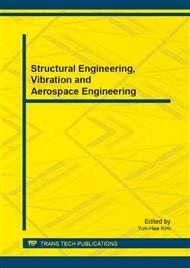[1]
www. horstman. co. uk.
Google Scholar
[2]
U. Solomon, Chandramouli Padmanabhan. Semi-active hydro-gas suspend- sion system for a tracked vehicle [J]. Journal of Terramechanics, 2011, 48: 225-239.
DOI: 10.1016/j.jterra.2011.01.002
Google Scholar
[3]
Choi SB, Park DW, Lee DY. Optimal control of an electrorheological fluid suspension system for tracked vehicles. Proc IMechE Part D: J Automob Eng 2005, 219: 843-55.
Google Scholar
[4]
James C. Poynor. Innovative design for magnetorheological dampers, Blacksburg, Virginia, (2001).
Google Scholar
[5]
Andrea C Wray, Francis B Hoogterp, et al. Magneto-rheological Fluid Semi-Active Suspension Performance Testing [R]. U.S. TARDEC Technical Report, NO. 13882, (2003).
DOI: 10.21236/ada421680
Google Scholar
[6]
Andrea C Wray, Alexander R Jimenez, et al. MRF Semiactive Suspension System Performance Testing on a Stryker Vehicle[R]. U.S. TARDEC Technical Report, NO. 15199, (2005).
DOI: 10.21236/ada443701
Google Scholar
[7]
C. Poussot-Vassal, C. Spelta, O. Sename, et. al. Survey on Some Automotive Semi-Active Suspension Control Methods: a Comparative Study on a Single-Corner Model. 18th IFAC World Congress, Milan: Italy, (2011).
DOI: 10.3182/20110828-6-it-1002.00446
Google Scholar
[8]
Saad Bin Abul Kashem, Mehran Ektesabi, Romesh Nagarajah. Comparison between different sets of suspension parameters and introduction of new modified skyhook control strategy incorporating varying road condition[J], Vehicle System Dynamics, 2012, 1-18.
DOI: 10.1080/00423114.2012.659743
Google Scholar
[9]
S. Savaresi, C. Spelta. Mixed sky-hook and ADD: Approaching the filtering limits of a semi-active suspension [J]. ASME Transactions: Journal of Dynamic Systems, Measurement and Control, 2007, 129(4): 382-392.
DOI: 10.1115/1.2745846
Google Scholar
[10]
Savaresi, S. and Spelta, C. A single sensor control strategy for semi-active suspension. IEEE Transaction on Control System Technology, 2009, 17(1): 143–152. ].
DOI: 10.1109/tcst.2008.906313
Google Scholar
[11]
J. Lu. A frequency-adaptive muti-objective suspension control strategy [J]. ASME Journal of dynamic systems, Measurement, and Control, 2004, 126(3): 700-707.
DOI: 10.1115/1.1789979
Google Scholar
[12]
Peng Zhizhao, Zhang Jinqiu, Gao Yongqiang et al. Structure design and magnetic circuit optimizing simulation of vane MRF damper. Proceeding of 2011 2nd International Conference on Mechanic Automation and Control Engineering , 4404-4407.
DOI: 10.1109/mace.2011.5987981
Google Scholar
[13]
C.P. Vassal, S.M. Savaresi, C. Spelta, et al. A Methodology for Optimal Semi-Active Suspension Systems Performance Evaluation[C]. Proceedings of the 49th IEEE Conference on Decision and Control, Atlanta, Georgie USA, (2010).
DOI: 10.1109/cdc.2010.5718058
Google Scholar


